Portland’s second-most-ridden neighborhood greenway is being lined up for possible improvements.
Southeast Clinton Street currently sees auto traffic volumes near 26th Avenue that are triple the city’s target for a neighborhood greenway and long stretches where auto speeds are 6 to 8 mph above the 20 mph limit.
Three months ago, after joining Transportation Commissioner Steve Novick to call a summit about bike safety, Mayor Charlie Hales said the city “will experiment with diverters — which allow bicycles through but block cars — at different locations.”
It was the city’s single most substantive response to a series of major biking collisions this spring, and followed years of pressure from the Bicycle Transportation Alliance and a year of noisy organizing by BikeLoudPDX.
In a mailer that arrived at nearby addresses Tuesday, the city announced an open house to start discussing the possibilities. It’s Wednesday, Sept. 16, from 6:30 to 8:30 p.m. at Abernethy School, 2421 SE Orange Ave.
We reported in July that the city had chosen Clinton as the site of the first such experimental diverter or diverters. Hales’ concept of on-the-ground experiments was inspired in part by the successful recent demos by Better Block PDX of better walking and biking spaces on 3rd Avenue and Naito downtown.
Advertisement
Last week, a major report from the city about the state of its neighborhood greenways named Clinton Street as one of five bike routes that need of some combination of diverters, speed humps or other traffic-controlling and calming measures. (Another was Lincoln-Harrison-Ladd, the city’s most-ridden neighborhood greenway.)
At stake is whether the crucial bikeway through Southeast Portland can be made comfortable enough to appeal to bike users of all ages and abilities. Also at issue: whether making it more complicated to navigate Clinton in a car might threaten the businesses that make Clinton such a useful part of its neighborhood.
Years ago, when the city took a political beating over installing a diverter at Clinton and Chavez, some city staffers swore off diversion projects.
But a lot has changed in the years since. Division Street’s population boom has increased the number of people who live close to Clinton’s businesses. Thanks in part to that diverter at Chavez, the number of people biking on Clinton during rush hour has doubled since 2006. Today, bikes account for a bit more than half the traffic on Clinton during the evening peak hour.
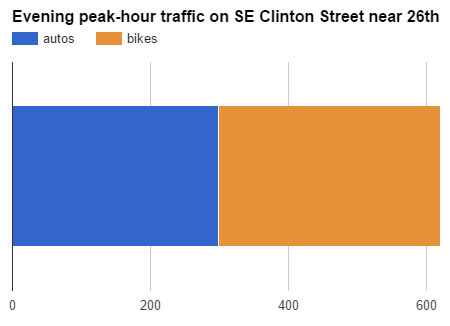
Most of all, the Clinton bikeway may have never had such an indefagitable and organized group of fans. In the last year, they’ve organized a month-long festival to celebrate the Clinton bikeway’s 30th birthday; won a series of seats on the Richmond Neighborhood Association Board; and conducted their own volunteer traffic analysis in case the city missed a chance to count the traffic itself. (The city didn’t actually miss the chance, so our understanding of Clinton’s traffic patterns is now even richer.)
Speaking of that volunteer traffic analysis, here’s the detailed set of recommendations for Clinton diverters prepared pro bono by one of the activists, traffic engineering pro Brian Davis of Lancaster Engineering. If you’re interested in attending this month’s open house, it might make for some good homework.

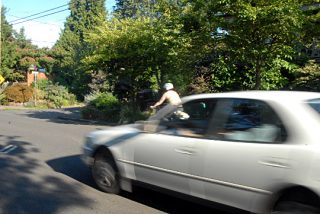
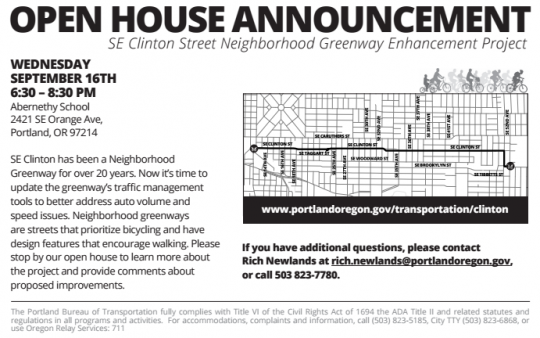
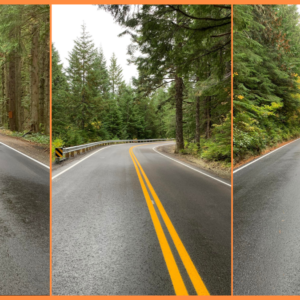
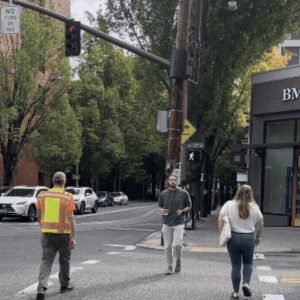


Thanks for reading.
BikePortland has served this community with independent community journalism since 2005. We rely on subscriptions from readers like you to survive. Your financial support is vital in keeping this valuable resource alive and well.
Please subscribe today to strengthen and expand our work.
How about another chicane with trees for SE Clinton? Speed bumps help dump oil from leaking cars.
Big dreams might help here. I’d like to see 26th and Clinton turned into a pedestrian plaza. That would have the most positive effect on the businesses there, although they would have to see it to believe it. It would also help with the car traffic issue.
We’ve got a plan for that.
It took a year of lobbying to get the city to listen, but I’m glad this is finally happening. Although, I’m disappointed that there wasn’t funding allocated to implement last year’s Better Block plaza at 26th nor for a Chavez-style signal/diverter at 50th.
Thanks, everyone, for your diligence and refusal to let go of this issue! Can’t wait for Clinton to be bikeable again.
“auto speeds are 6 to 8 mph above the 20 mph limit.”
While the goal is to get to 20mph, Clinton is not 20mph ATM. Did you mean 30mph?
20 mph is not the legal limit, but it is the goal for neighborhood greenways to get 85th percentile speeds below 20 mph. By law the city can’t lower the speed limit to 20 mph until automobile volumes are lowered, so there’s a chicken or egg issue. We need to lower volumes first, and then the speed limit can be changed.
parts of Clinton are 20 mph, but not below 39th… although speeds are higher than 20 mph on the 20 mph sections…
Spiffy, which parts are posted 20 mph?
85th percentile speed is the standard of measure. The highest 85th percentile speed measured on Clinton in 2015 is west of 49th and was 27 mph. in 2014 there was a higher one east of 41st, 28 mph.
Clinton east of Chavez does not have speed bumps yet.
actually, yes, parts of Clinton are indeed 20mph.
Which parts? If you mean the 1 block school zone, ok, but hardly much of an effect on traffic.
I’d like to see a complete bike-centric redesign of Clinton and 26th.
Which looks like what?
Diversion every 3-5 blocks including entry diverters at 50th, 34th, 26th, 21st, 17th and 12th. Make 26th a rest stop/ active transport plaza.
Continue this on Woodward eastbound, then design an “East Clinton Promenade” for people and bikes that anchors 79th to the I 205 path to the east……ONLY local car traffic block by block.
Speed bumps are a waste of money…..they are used because even though this is a grid, people are too timid to use diversion properly. A street designed FOR BIKES in the city is a series of cul-de-sacs constructed through either full diversion, or back and forth semi-diverters.
Portland is WAY too timid for this, but that is what is GOING to be needed if we want to come even close to our mode share goals. Not on every greenway, but on the truly bike friendly ones.
What Terry describes should be seen as table-stakes for a 21st century Portland. Platinum would be to take that approach to all local service streets.
Speeding has been measured on 5-block street segments in Portland with under 1,000 trips per day. Your hypothesis that speed bumps have no purpose is easily disproven.
Heres a simple solution that wont require any physical upgrades to the road.
https://www.change.org/p/steve-novick-charlie-hales-prohibit-automobiles-from-passing-on-portland-neighborhood-greenways
While implementing a “motor vehicles cannot pass” law on greenways would be an awesome solution (that I myself have raised previously), the petition itself is a joke. I don’t think “PDOT” has that kind of legislative power…
Calling it a joke is a bit harsh. If you have some actual constructive criticism I’d love to hear it.
PBOT cannot create that law. It would need to be allowed at the state level. Better to write your state representative instead.
Speaking out of ignorance here – does PBOT have not the authority to create “no passing zones” on its roads as it deems necessary for safety without a state legislative action?
It can stripe a street with double yellow centerline, if it meets standards (810.120).
810.120 Designation of no passing zones. (1) Each road authority may do the following on its own highways:
(a) Determine where overtaking or passing or driving to the left of the center of the roadway would be especially hazardous; and
(b) Establish zones on the roadway where overtaking or passing or driving to the left of the center of the roadway are prohibited because such would be especially hazardous.
(2) To establish a zone under this section, a road authority must do all of the following:
(a) Determine that a need for a zone exists in accordance with standards and procedures adopted by the Department of Transportation.
(b) Mark the zone by appropriate signs or by a yellow unbroken line on the pavement of the right-hand side of and adjacent to the center line or a lane line of the roadway to indicate the beginning and end of the zone.
(3) Penalties are provided under ORS 811.420 for passing in a no passing zone designated under this section. [1983 c.338 §156]
is there anything in the ORS that prevents pbot from installing no passing signs without striping a double yellow centerline?
Yeah, that’s what I had in mind after reading that law….
Pavement markings are continuous and provide constant positive direction. An occasional sign would be more difficult to enforce in this case.
But a double yellow doesn’t prevent cars from passing bikes (in actuality or legally), right?
i don’t think a double yellow is what most people had in mind.
Paint never stops anyone. Passing would be illegal if a double yellow centerline could be installed.
do not pass signs are part of the mutcd:
http://mutcd.fhwa.dot.gov/htm/2009/part2/fig2b_10_longdesc.htm
and they would not apply to people cycling since they are allowed to share lanes in OR.
Bad idea. Streets are more comfortable to bike on when cars can pass, as long as volumes are low. Try riding on a street with a double-yellow line and you’ll feel how uncomfortable it is to have a car revving behind you, with the driver getting frustrated. Much better to let them pass.
On a Neighborhood Greenway what you call the sound of a frustrated driver is what I hear as the sweet sound of someone who will choose a different route next time. (Or better yet, a human powered vehicle.)
And while you are reveling in driver frustration, other cyclists will still feel the driver breathing down their necks. It does not create a comfortable riding experience.
Not if that auto is the #10 bus line.
It’s time to divert the #10 bus over to Division for the 6 blocks of its current E-W route on Clinton.
I’m not sure the intersection at 26th and Division is big enough for a bus to turn.
Nearly everyone agrees with you (Trimet, PBOT, etc.) The problem is the bus cannot negotiate the turn between Division and Clinton.
That’s an argument based on laziness, which is common for those agencies when a potential solution requires effort to implement.
The #10 can barely negotiate the right turn at 21st & Clinton either. Cars have to stop 20-30 feet earlier on 21st or the bus has to wait until the street is clear. TriMet and PBOT have conveniently allowed this scenario to exist for years.
The stop line for the eastbound Division light and the northbound 26th light could be scooted back to allow sufficient turn radius for a bus. It’s not a common solution but it absolutely has precedent for being used around town.
yes, because antagonism always works, right?
If you look at how PBOT designs and applies sharrows etc, they are actively soliciting riders to calm traffic. It’s not the drivers that are right behind me that really change behavior based on this (sometimes they even get agitated) it’s the ones who are a few blocks away and because there are a bike riders staggered across the street width the drivers feel like they are on the wrong street and turn off before there is a conflict. I ride on Going St mostly, if I spent more time on Clinton I might be cowed too.
Mostly I ride in a manner that is legalistic and safe, but otherwise calculated to make drivers uncomfortable. I find this gives me wider berth and hopefully a safer ride. Also I hope it changes other road users expectations just a little.
I completely disagree with you. I think it first and foremost sets the right away standard so there is no question or confusion that if you choose to take a greenway you are expecting to go slow which will address the anxiety for both the motorist and cyclist alike. I don’t think that each driver trying to pass is doing so in a way that is malicious, rather they just don’t have an expectations or accountability to beehive a certain way. While we as cyclist may feel it to be aggressive to pass recklessly or for no need other than to race to the next stop sign drivers don’t see it the same way cause its excepted.
The best advantage to no passing on greenways it that is also inherently addresses the issue of speed. Most of the people speeding are only doing so to over take someone else.
All of this benefit with little cost what is so wrong about that?
excepted = accepted
🙁 if typos killed.
blaaa beehive? really? I hate auto correct somedays.
It converted “behave” into Austin Powers speak.
it’s not better to let them pass since they can’t usually pass legally as it is… a law against passing would let them know and not leave them guessing if they have a safe passing distance…
It seems especially dangerous to “just let cars pass” when they’re not guessing, but boldly believe, they have enough passing space. My worst experiences on Clinton have been riding down the dotted line, getting aggressively passed by cars who are now accustomed to speeding around bikes every other block on a westbound morning rush hour. What some cyclists do to “avoid conflict” and keep their ride peaceful actually makes it a lot harder for others.
Bicyclists roll through the stops signs at Ladd’s Addition, which is illegal, but doesn’t result in any actual safety problems and the result is Enforcement Action annually against scofflaw cyclists.
The average speed of motorists on Clinton is 6 to 8 mph above the statutory speed and the result is nothing.
By the way, I ALWAYS stop at the stop signs at Ladd’s Addition.
So YOU’RE the one!
Ha, I usually look twice and proceed, treating stop signs as yield signs. Unless there is a rather impatient motorist behind me, at which point i’ll take the full lane, stop and put a foot down and use all the caution in the world. Boy, do they begin to appreciate a yielding cyclists versus a law to the t abiding cyclists.
I’m guessing cyclists aren’t calling the Safe hotline as much as the Ladd’s residents are…
JR, the statutory speed on Clinton is 25 mph and the high 85th percentile is 27-28 mph. So ‘speeding’ by the standard definition is 2-3 mph over statutory. 50th percentile speeds hover around 20 mph.
I also come to a full stop every time.
If y’all hate the enforcement actions there, remember what would result from an enforcement that didn’t catch anyone. Every time they catch you they’re building budget for the next enforcement.
In that place, I strongly urge you to stop completely every time. It costs seconds and may reduce that kind of targeted enforcement overall.
And while you’re at it, if this intersection is such that stopping isn’t really necessary, contact the City and ask them to change the stop sign to a yield sign. The result will be the same safe behaviour but it’ll then be legal.
Clinton attention is great, but 6-8 over the 20 mph is nothing. This city has virtually no enforcement and hundreds of neighborhoods being tormented by reckless, noise polluting speeders.
I’d like a city/PPB action plan to regain control of our streets.
Maybe roving packs of neighbors exercising their crosswalk right-of-way. (811.028 allows you to place many things in the street to signal your intention to cross “including but not limited to” very large rocks, hammers, tire spike strips…)
An opinion is not fact. I agree that more enforcement is needed, and believe that will require more enforcement personnel.
When did the city get ‘hundreds of neighborhoods’?
Are we to broadly paint all people driving as evil, when it is likely a small to moderate percentage? If so, the same rule should apply to people that bike.
Hyperbole dilutes the credibility of your protest.
I’ll place a cooler of beer on my porch and you can tally the large percentage of law abiding drivers cruising at 20-25 mph.
Since you’re being picky: Hundreds of streets (agreed).
There was little (none) hyperbole in my post. I certainly can’t, and didn’t, claim drivers are evil for meeting the expected norm. Enforcement, followed by design, needs implementing to curb the habitual accepted behavior of exceeding the posted or safe speed limit.
Ask MADD. redesigning to change beliefs is likely to be ineffective. Better enforcement helps, as do better laws, but Clinton has almost all the bells and whistles available, and will soon have all of them.
Uh? I’m pretty sure road diets have been proven effective? Diverters, speed-humps, and speed reader boards too?
Whatever your desire to argue (and the desire seems strong with you), people don’t speed when they believe the odds of being caught are high. People don’t speed where going 15 miles over the speed limit feels uncomfortable. Or to better quantify: most people. and my point reaches beyond Clinton.
Road diets only work to slow traffic when there is traffic. Speed bumps get less effective with higher speeds. Diverters reduce traffic, so reduce risk of crash, but do not slow people driving in between, and speed is the primary factor in crash deaths. Speed reader boards? haven’t seen any studies on long term effectiveness.
Electric pop-up bollards which only lower at a 20mph pace? Do those work better than diverters every 1-2 blocks?
Sarcasm? cost? liability? Seriously?
Totally not sarcastic, but actually not so concerned about keeping drunk drivers safe even if PBOT has them at the top of the pyramid. Liability and cost might not be in our favor with electric bollards, though they otherwise would provide excellent connectivity and safety for all modes. Trade-offs being trade-offs, I guess we better go ahead and put diverters across every other block.
TJ,
BTW, if data has been collected on your street we can already see how many, on average, are law abiding. Give us a street and range, collector to collector.
Meh, once the city ‘engineers’ something for cyclists, I usually avoid that route completely. Because the ‘engineering’ is usually so sub-par as to be laughable and dangerous at the same time.
Examples?
Too many to list. But we can start with the giant SNAFU at the east end of the Tilikum crossing, the SW Broadway bike lane, and the new N. Williams bike lane.
Capitol & Terwilliger, SW Multnomah, Moody, Bond. I haven’t ridden NE Multnomah or Cully — are those the good ones? I was going to try my cargo bike on the bike ladder up the Gibbs stairs when the elevator was down on Tilikum preview day, but the handrail sticks out too far. The slip-lane crosswalk at Harbor Dr and River Pkwy. Left from Harrison onto Naito with a layover in Copenhagen is a recent “improvement”?
ANY overpass that has stairs should not be considered a “bike facility.” By city definition, bike facilities need to be able to handle “Large numbers of bikes.”
The only elevator in the city that fits that definition is the Washington Park Max Stop. All the other ones, including Gibb’s I avoid…the wheel wells allowed under ADA are USELESS if you have panniers….and why wouldn’t you in the city? The elevators only work part of the time and are slow as hell…….
RAMPS……we should ALWAYS include ramps. The Layfeytte bridge is laughable as a connection from Gladstone to SE 17th…..Two stairwells? Come on….
I went to the Lafayette bridge yesterday afternoon. The west elevator was not working, and the I spoke with the guy from Brunz construction who built the new bridge facility as he was trying to get the new elevator back to working order. As I took the stairs and tried to use the wheel gutter, my pedals clanged on the guardrail and my handlebars got caught in the hand rail. I asked the builder about the wheel gutter and he said he knew that it didn’t work and that he just built it the way he was told by the engineers. So, I asked him if he could fix it so it would be positioned correctly, and he said that was not part of the current scope of work.
the bridge is very nice, although not really a bike specific design. It’s trying, but just got it wrong – much like many details on the Orange MUP. I agree that ramps are the answer and should always be the preferred design. Can’t wait to take my kids to school on this bridge and wonder what/who unmentionables we will find in the elevators – assuming they are working. I guess it’s going to be cyclocross training on the stairs and if you take your cargo or trailer bike there, or heavy loaded paniers, get ready to roll the dice on the elevators, and I’m not sure how my kids are going to do hauling their bikes on the stairs. Of course, the alternatives are poor options and way out of the way as a neighborhood connector from Brooklyn.
Can’t address this problem without taking a hard look at how we’ve allowed development to run rampant on Division. We’re clearly beyond the density that Division can support (at least up to around 39th). A lot of those Clinton drivers are looking for Division St. restaurant and food cart parking. We can’t keep building foodie-destination neighborhoods that attract thousands of customers every night while ignoring the demand for parking. I’d guess that a very small number of Division St. diners ride bikes, walk or take public transit. On the other hand I see plenty of people circling the area in luxury SUVs. The obvious solution would be a public parking ramp. Works for downtown, after all.
Until then, prepare to endure an endless stream of tourists and wealthy visitors clogging up Clinton and doing dangerous stuff. Diverters will help, but won’t stem the tide. Make it easy for people to park and there will be less frustration and aggression from them.
In my experience, the people trying to park are not the problem. They’re driving slowly and only for a few blocks, and don’t tend to pass people on bikes. It’s people who are driving on Clinton for more than a few blocks and that pass aggressively that are the problem. These people are mostly cut-through traffic, but based on observing some of them turn on streets between 28th and 37th, I think some are neighborhood residents.
The people cutting across Clinton, or using it as a thoroughfare, are doing so to avoid the parking snags on Division, which used to be relatively free-flowing until developers put a ton of apartments, condos and destination dining all withing a few blocks of one another. Now, one car hits the brakes to back into a spot and you’ve got a 10+ car backup that makes thru-drivers look for the first opportunity to bail for an alternate route. If we’d built adequate parking, then maybe Division would have had a chance at still being a useful arterial. But we can’t just say “POOF! It’s an entertainment district now!” and expect this to have zero effect on the infrastructure that we never want to upgrade. It’s a real problem and one that can no longer be ignored.
Build it and they will come. The more parking you build, the more people will drive there…and traffic gets worse. We know this from decades of traffic engineering studies. We will get denser as this country, for the time being, still allows for freedom of movement and SE Division is considered one of the “most livable” neighborhoods in the country.
Add congestion priced smart meters that can be accessed from one’s smart phone. This combined with residential permit parking would really do wonders.
That would however mean people would actually have to PAY to store their private vehicles on PUBLIC property. I know…how shocking.
This is laughable. The problem is not too many people. The problem is too many people taking up 10x the space they need to take up by driving cars. If Division were only open to busses and bikes, there would be ample space.
What’s laughable is the idea that people will magically stop driving in our lifetimes. Whether it’s self-driving Ubers or just plain old trucks (I am told that Americans are particularly fond of trucks), they’re here to stay. The numbers support this, too. Of course when the economy was down and people didn’t have jobs to drive to, the stats were spun as some sort of car-free revolution that the Millennials must have come up with. Whoops, all that went away when the jobs came back, and bike commuter ridership continues to decline across Portland. Funny, eh? Now you can claim that it’s caused by not having enough unproven stuff like cyclotracks and bike boxes and invoke Amsterdam whenever you think you can win an argument (have you even been there?), but the fact of the matter is that we cannot simply ignore the automobile, and doing so will continue to hurt cyclists, pedestrians and public-transit-users alike. I’m not looking forward to a gridlocked city that only people rich enough to afford a good “WalkScore”(tm) can enjoy; I want Portland to be accessible to all users. And considering how much our economy seems to depend on tourism lately– and I’m talking about the busloads of people lined up in front of Voodoo or Popular Ice Cream Place– who almost universally rent cars at the airport. I apologize if these facts are upsetting to you, but with time and perhaps some professional counseling, I am confident that you will come around. Ciao!
You can’t build your way out of congestion. Show me a city that has figured out a way to eliminate vehicle congestion. Do people in Houston have shorter commutes than people in Portland? Do people in Los Angeles spend less time sitting in traffic? Both cities have built out massive freeway networks at the expense of mass transit and active transportation. How’s that working out for them?
I agree and what would be even better would be the expectation that when driving, you also simply cannot get through the street you’re going down. That every 5 or 10 blocks it ends in a bike permeable cul-de-sac and you have to turn back. With the right signage and other features, it should be obvious before they even drive down a greenway that it’s different than other streets and that they will not be able to drive through it to get to somewhere else. This would mean only those living on or visiting this street will want to drive down it.
Of course even those that living on or visiting will also no longer be able to ‘drive down it’ for very long.
That is the whole point. The locals will learn their new route, the rest will avoid it….then the street will be for people and bikes.
Tillikum east bike/ped route